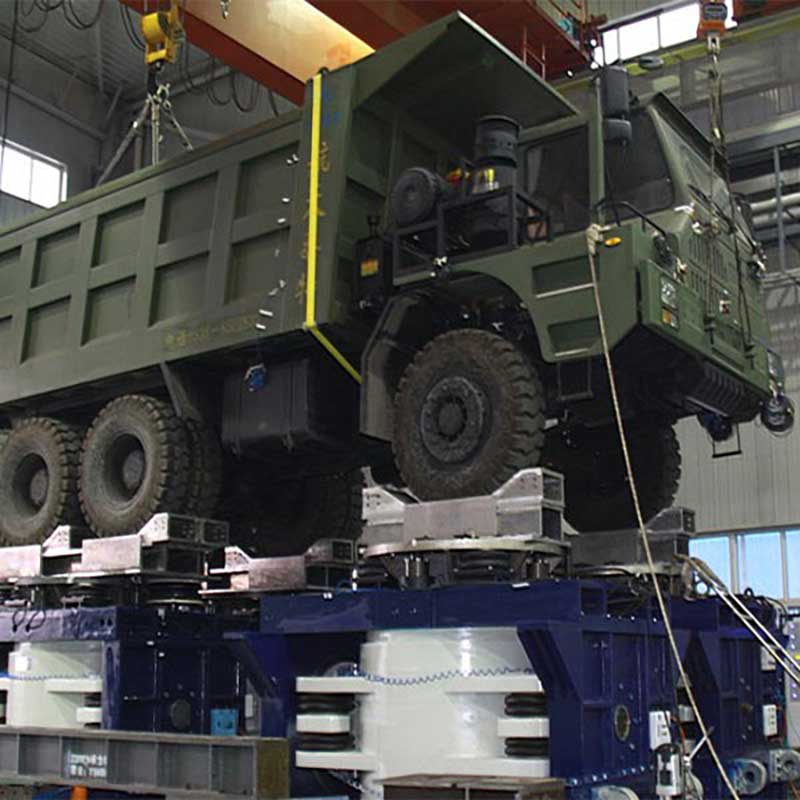For automotive vibration testing, outdoor road testing is ideal because it most realistically simulates actual driving conditions. However, outdoor road testing is not always feasible, with some limitations such as weather conditions, terrain limitations, and high testing costs.
To address these issues, the automotive industry has developed indoor test devices, such as four-column vibration test table, to simulate outdoor road conditions. The test bed is a hydraulic system that can independently drive the four tires of the car to simulate various road conditions. Compared with outdoor road testing, this indoor testing method has the advantages of high repeatability and accelerated testing process.
Engineers often use four-column vibration test setup for durability, NVH(noise, vibration and roughness), and frequency response tests. This is because road conditions have the most critical impact on the suspension and frame of the car, and the four-column test table is a good way to verify the performance of these key components. Overall, the four-column vibration test table provides an efficient and flexible indoor test solution for automotive vibration testing development, which helps to improve product quality and shorten the development cycle.

To perform a four-column automotive vibration testing device, engineers must first create a detailed test profile. This profile is used to control the vibration controller, which transmits the corresponding signal to the hydraulic system of the four-column test stand to excite the device under test (DUT).
Ideally, engineers would collect actual road test data and use it as a basis for the indoor test curve. This ensures that the simulation environment reflects the actual conditions of use as closely as possible. However, if field test data is not available, engineers can also refer to historical data or relevant standards to develop a test curve.
After determining the test plan, engineers usually choose to use accelerated testing. This is because the car is subjected to many years of shock and vibration during actual use, and accelerated testing helps to detect possible fatigue problems in advance and determine the service life of the component or complete vehicle.
In short, four-column vibration test table require engineers to carefully design test configurations and develop test curves according to actual conditions of use or relevant standards. Using accelerated test methods can help shorten test cycles and detect potential reliability problems in a timely manner. This is essential to improve product quality and shorten the development cycle.
On a four-column vibration test setup, four vibrators are excited along the same axis (usually the z-axis). Engineers play back the recorded data file of each wheel, as if the vehicle were actually driving, while playing back the signals.
The vibration controller constantly compares the actual acceleration of the vibration test table/device under test (DUT) with a preset reference value to generate the corresponding drive signal. The control algorithm adjusts the shape and amplitude of the drive signal to minimize the difference between the actual control signal and the reference signal.
This process of comparing the control signal with the reference signal forms a feedback control loop. When the controller independently sends drive signals to multiple vibrators, a multi-channel control loop is formed. On a four column vibration test bench, this multi loop control method is very common when multiple vibrators on a single axis jointly control the test object.
In general, the four-column vibration test setup uses multiple vibration test table to simulate the complex vibration conditions of the actual vehicle driving, and the controller constantly adjusts the drive signal to track the preset reference signal, thus achieving precise control of the device under test. This multi-loop control method can effectively reproduce the vibration characteristics under the actual operating conditions, and can simulate the automotive vibration testing more accurately.
Reference: Proceedings of the 2004 International Conference on Noise and Vibration Engineering
www.researchgate.net /publication/253947439_Experimental_multivariable_tracking_control_on_an_automo -_tive_vibration_test_rig
